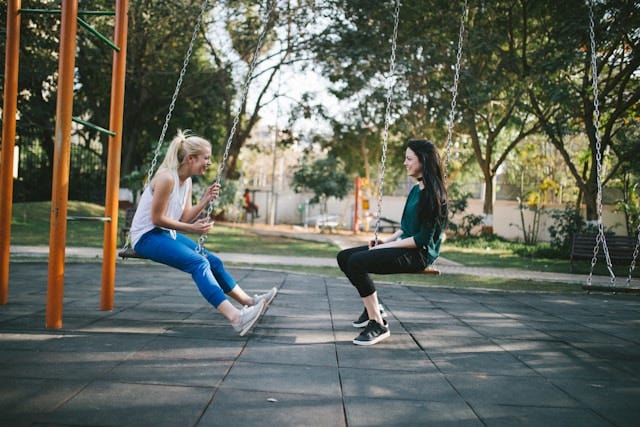Stress, Dopamine, and Addiction: Why We Keep Reaching for More
How stress and dopamine work together to fuel bad habits—and what you can do to break the cycle.
My Personal Experience with ADD, Stress & Addiction
I’ve always known my brain works a little differently. Living with ADD means my dopamine system isn’t exactly smooth sailing—it’s more like a rollercoaster. High highs, low lows, and an almost instinctive urge to chase the next hit of stimulation.
I struggled for years with many types of addiction: dieting, exercise, food, sugar, alcohol, cigarettes and many more. I rarely did anything in modest amounts. In fact a good friend told me once that I was not a woman of half-measures, and I’d have to agree. When I’m in, I always seem to be all in.
For years, I didn’t realize how much stress played into this. The more overwhelmed I felt, the more I craved something—sugar, booze, scrolling, binge-watching, even overworking. It wasn’t just about seeking pleasure; it was about escape, relief, and—let’s be real—survival.
When the chips are down, a smoker's a smoker. Though I engaged my addictions most of the time, when things got hectic and stressful, I’d go further down the rabbit hole. I’d drink more, diet more, smoke more, binge watch TV more. Just more, more, more.
I majored in Psychology in university, so I had a background in understanding hormones and neurotransmitters—but at the time, it felt more like textbook knowledge than something truly applicable to my own life.
When I got sober in 2015, I really started diving into the science, and everything clicked: stress, dopamine, and addiction are tangled up in ways I had never fully understood.
This began a lifelong journey to change how I regulated my dopamine, so that I could live more fully, handle stress in a healthy way, and just overall improve my life.
Why It’s So Hard to Break the Cycle
We live in an era of endless stimulation. With a single tap, we can scroll, shop, snack, or stream our way to temporary relief from boredom, stress, or exhaustion. But have you ever wondered why it’s so hard to stop—why you reach for your phone even when you know it won’t make you feel better?
The answer lies in dopamine, stress, and the hidden addiction cycle that most of us are trapped in.
Dopamine: The Brain’s Reward Currency
For years, dopamine has been misunderstood as the "pleasure chemical." But in reality, dopamine is not about pleasure—it’s about pursuit. It’s the neurotransmitter that drives motivation, focus, and goal-directed behavior. When we accomplish something—whether it’s finishing a task or eating a piece of chocolate—dopamine surges, reinforcing that behavior.
But there’s a catch. Dopamine is highly addictive.
Dr. Anna Lembke, psychiatrist and author of Dopamine Nation, describes how modern life bombards us with dopamine triggers—social media, ultra-processed foods, binge-worthy shows—all designed to keep us craving more. The more we indulge, the more our brain adapts, reducing our dopamine sensitivity and making natural rewards (like reading a book or going for a walk) feel... dull.
Neuroscientist TJ Power explains that our brain’s dopamine system works like a seesaw—when we flood it with too many quick hits, we tip the balance. Instead of feeling motivated, we become unmotivated, restless, and constantly seeking the next fix. And stress only makes this worse.
Stress & Dopamine: The Perfect Storm for Addiction
Stress is more than just an unpleasant feeling—it’s a biochemical process that directly impacts dopamine levels. When we’re stressed, our brain releases cortisol, which:
Disrupts dopamine production, making us feel depleted and unmotivated.
Increases impulsivity, making us crave quick fixes like junk food, alcohol, or doomscrolling.
Hijacks our reward system, making long-term goals feel impossible while short-term pleasures feel irresistible.
This is why, after a long, stressful day, we instinctively reach for a glass of wine, a tub of ice cream, or an hour-long social media binge. The brain is simply trying to self-regulate. But over time, this cycle leads to dopamine burnout, where we need even more stimulation just to feel normal.
ADD, Dopamine, and the Struggle to Self-Regulate
For people with ADD (Attention Deficit Disorder), this cycle is even more pronounced. ADD brains naturally produce less dopamine, making it harder to focus, stay motivated, or resist impulses. This can also lead to higher reward-seeking behavior.
As a result, people with ADD often develop stronger cravings for dopamine hits—whether it’s through sugar, caffeine, social media, or even workaholism.
And because stress depletes dopamine even further, people with ADD are more vulnerable to addiction cycles—constantly chasing stimulation to feel balanced.
Breaking Free: How to Reset Your Dopamine System
The good news? Our brains are adaptable. We can rebalance dopamine and break free from addictive loops with a few intentional strategies:
1. Dopamine Fasting – Giving Your Brain a Chance to Reset
Dr. Anna Lembke, psychiatrist and author of Dopamine Nation, explains that when we constantly chase dopamine—whether through social media, sugar, shopping, or even overworking—we end up in a cycle of short-term pleasure followed by long-term pain (like burnout, anxiety, or addiction).
Her solution? Dopamine fasting, which isn’t about avoiding all pleasure, but about giving your brain time to recalibrate so it can produce dopamine naturally again.
How to do it:
Identify your biggest dopamine triggers – What’s the thing you reach for compulsively when you’re bored, stressed, or exhausted? Social media? Netflix? Caffeine? Sugar?
Take a break – Lembke recommends removing that stimulus for 24 hours to 30 days, depending on how dependent you are on it.
Expect withdrawal – When you first cut out high-dopamine activities, you’ll likely feel restless, irritable, or bored. That’s a sign your dopamine system is resetting.
Reintroduce in moderation – Once your brain has rebalanced, you can bring back the activity in a more mindful way, avoiding binge patterns.
But what if willpower isn’t enough? This is where self-binding comes in—a technique Lembke highlights as crucial for breaking addictive cycles. Self-binding is all about setting external guardrails that make it harder to engage in compulsive behaviors.
For example:
Time-based self-binding: Deleting social media apps during the workday or setting screen time limits.
Space-based self-binding: Keeping junk food out of the house so it’s not an easy go-to.
Category-based self-binding: Swapping addictive versions of activities (e.g., binge-watching reality TV) for less compulsive alternatives (like watching a single documentary).
Lembke shares examples of people who, by strategically removing access to their biggest dopamine triggers, were able to reset their brains and regain control over their habits.
One powerful example? A patient struggling with compulsive social media use took a 30-day break from scrolling. At first, they felt worse—anxious, restless, and disconnected. But by the end of the month, they reported improved focus, better sleep, and a deeper sense of happiness.
2. Natural Dopamine Boosters – Sustainable Pleasure
Once you've cleared out the dopamine overload, the next step is building habits that naturally support dopamine production without leading to burnout. These include:
Exercise – Even 20 minutes of movement boosts dopamine and improves mood.
Cold exposure – Ice baths or cold showers trigger a lasting dopamine release without the crash.
Deep work – Focused effort (without distractions) creates a steady dopamine release that feels satisfying.
Meaningful social interactions – Real conversations stimulate dopamine in a healthy, non-addictive way.

3. Lowering Stress = Better Dopamine Balance
When stress hormones (like cortisol) are high, dopamine doesn’t function properly. This is why chronic stress leads to low motivation, brain fog, and exhaustion.
To lower stress and support dopamine:
Breathwork & meditation – These lower cortisol, helping dopamine function better.
Quality sleep – Poor sleep disrupts dopamine receptors, making it harder to feel motivated.
Nature exposure – Even 10 minutes outside has been shown to reduce stress and improve mood. (Extra bonus, it’s so pretty!)
4. An Evening Routine That Leaves You With More Dopamine in the Morning
Neuroscientist TJ Power emphasizes that what we do before bed directly impacts our dopamine levels the next day. His key suggestions:
✅ Cut screen time 1–2 hours before bed – Scrolling late at night overloads dopamine, making it harder to feel motivated in the morning.
✅ Do something low-stimulation – Reading, journaling, or stretching keeps dopamine stable instead of spiking it.
✅ Reflect on small wins – Writing down 2–3 things you accomplished primes your brain for motivation the next day.
✅ Go to bed early – Dopamine naturally replenishes during sleep, so getting quality rest is key.
5. Intentional Dopamine Use – Train Your Brain to Link Dopamine to Effort
Neuroscientist Andrew Huberman recommends pairing dopamine with effort, so instead of mindlessly scrolling for a dopamine hit, you train your brain to associate dopamine with real rewards—like completing a workout or learning a new skill.
For example:
Instead of scrolling TikTok for entertainment, watch an educational video and take action on what you learn.
Instead of stress-eating sugar for comfort, cook a nutritious meal that still feels rewarding.
Instead of chasing quick dopamine from shopping, set a goal and reward yourself after accomplishing it.
The idea isn’t to eliminate dopamine—but to use it wisely so it fuels motivation, not addiction.

Final Thoughts: Are You Stuck in the Cycle?
For me, learning about the dopamine-stress connection has been life-changing. It’s helped me recognize my own patterns, cut back on habits that were draining me, and find better ways to self-regulate without self-destruction.
And while dopamine plays a major role in addiction, it’s not the only factor. Addiction is complex, involving a mix of brain chemistry, emotional regulation, trauma, environment, and habit formation—not just the pursuit of pleasure.
But even though it’s not the only cause, working on your dopamine-stress balance can make a huge difference. Managing stress and understanding how it drives cravings can help you regain control and build healthier coping mechanisms.
I know it’s made a huge difference for me, and I am proud to say I’ve been sober for over 10 years, and I’m loving it! 🥳
What about you? Have you noticed stress affecting your habits? Do you struggle with dopamine-driven cravings?






Such an insightful post! You've shared so many valuable tips.
Not using my phone first thing in the morning and logging off digitally two hours before bed have made a huge difference in regulating my dopamine levels. These small shifts really improve how you feel.
lots of great tips and information, Genevieve!
for me, I struggle the most in the evening when my willpower/self-control is at its lowest point
the evening is also the time I go to Substack, and try to do a few productive tasks
but having humanity's total knowledge at my fingertips and clickbait news and articles, I find it hard sometimes to be efficient and focused
and then to unplug and go to bed early
it's FOMO
it's a craving to do just one more thing
it's fear of not working hard enough
so I guess I should cut my screen time 1-2 hours before bed, as you advise
my mornings could be more energetic this way